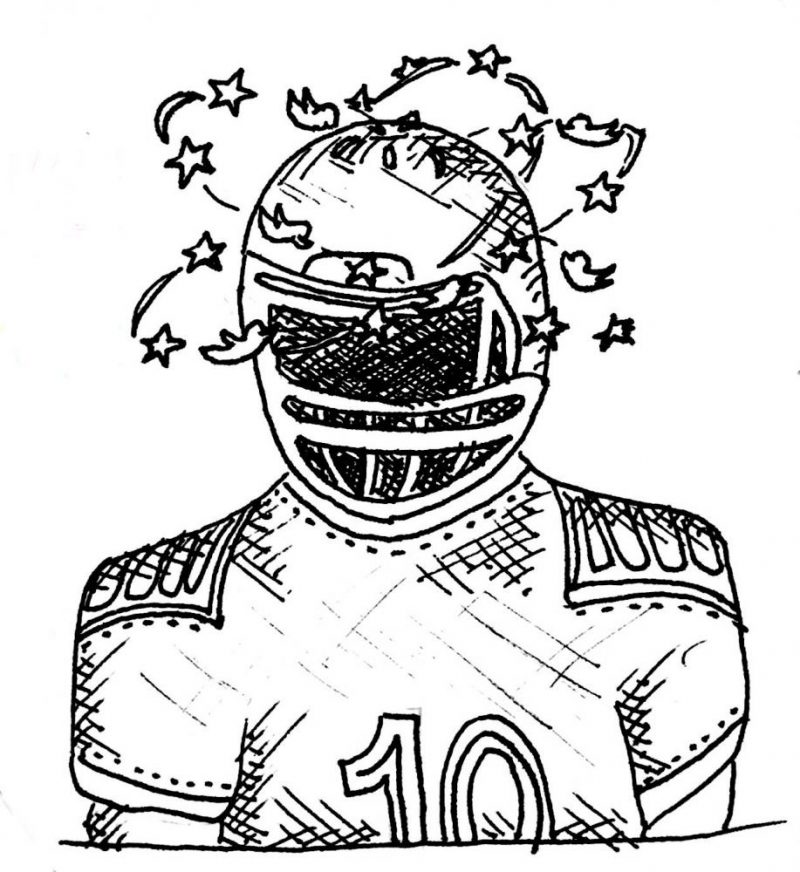Studies show increased CTE risk
October 4, 2017
By Caleb Weinstock
A hit to the head from a charging, 250-pound football player will leave a visible bruise, but it may also leave a hidden degenerative condition, more often than expected.
In a recent study on Chronic Traumatic Encephalopathy (CTE), a serious brain trauma disease, 99 percent of NFL players, 91 percent of college football players and 21 percent of high school players had the disease. Of the 202 brains studied, 87 percent of the players were found to have CTE.
The study, which was published in the Journal of the American Medical Association (JAMA) on July 25, was led by Dr. Ann McKee, the director of Boston University’s CTE center. Although there is a large selection bias in the study since the brains donated were from families who had seen signs of mental trauma, many think that this study is very revealing on CTE.
“It could absolutely be a bigger problem than we know,” Dr. David Wright, director of Emergency Neurosciences at Emory University School of Medicine, said in an email to the Southerner. “We haven’t even begun to document the prevalence of CTE in the population.”
CTE is a degenerative brain disease where Tau proteins form clumps and kill off brain cells. The disease can also be found outside the realm of football in military veterans, soccer players and boxers. The effects of the disease are usually seen years after the impacts occurred in common yet very serious symptoms such as increased aggression, depression and paranoia.
CTE in the NFL
Talk of CTE before Boston University’s recent study showed up in the NFL in 2012 when Junior Seau, a 20-year NFL veteran and 12-time Pro bowler, committed suicide two years after retirement. After his death, Seau’s family donated his brain to the National Institutes of Health in Washington where researchers found Seau had developed CTE.
Aaron Hernandez, the former New England Patriots tight end who was convicted of murder and then committed suicide in prison, was shown to have a stage three progression of CTE. Hernandez’s case was especially startling because, according to Boston University, the average age of having the development of stage three is 67 years old. Hernandez died at 27. Hernandez had played in the NFL for three years. Although Hernandez’s violent end can not solely be credited to CTE, his name does add to the growing list of players, including Seau, who took their lives while having CTE.
Additional information on the disease is causing football players to question whether playing is worth the risk. Two days after Dr. McKee’s study was published, Baltimore Ravens offensive lineman John Urschel retired at 26, the prime age for playing football.
Although concussions are currently one of football’s most pressing health concerns, CTE is not only caused by powerful, concussive hits. The repetition of any type of head trauma accumulated over years of playing football, even if it does not cause concussions, is the biggest factor in producing the disease.
Children at Risk
Age is also a factor in who is affected the most. The younger a person is, the more at risk they are at in developing CTE. In Dr. McKee’s study, there were three players who had CTE from just playing high school football. Boston University added to its study on NFL players with another study revealing that people who played football before the age of 12 were much more likely to have risks of CTE than players who started after 12 years old.
Dr. Bennet Omalu, the doctor who first discovered and published findings on CTE in NFL players, is a leading spokesperson for discouraging parents from letting their children play football. In his book, “Truth Doesn’t Have a Side,” Omalu writes, “If someone knows the risks and chooses to play, God bless them. However, I would never play, and I would never allow my children to play, and I encourage my friends not to let their children play.”
Closer to Home
Emory’s Dr. Wright believes more changes are needed to football to make it safer.
“Several studies show that most clinical concussions occur when the rules are violated like spearing, targeting, head-to-head contact,” Dr. Wright said. “Quantifying and limiting exposure and trauma will be key, similar to a pitch count in baseball. Football can be safer if we are committed to making it that way.”
When asked to comment on the risk of CTE for Grady football players, coach Earthwind Moreland declined comment. Christian Jones, a former Grady defensive back who had a concussion in 2015, said he did not want to focus on what might happen and instead just play.
“I thought about the danger of brain injuries for a little bit, but then I tried to forget about it because I thought if I kept worrying about it, then that’s when something bad would happen,” said Jones, who graduated in May and runs track in college at Jackson State University.
Many people believe the risk is limited enough due to the increased regulations on head injuries throughout all levels of football.
“I don’t worry,” said Shanicka McClendon, mother of former Grady receiver Jacquez Sloan who is now at Western Kentucky University. “He has been playing for so long, [and] there is always a chance for you to get hurt in a contact sport, but the coaches and officials are properly trained. The game has changed, too; it’s safer now with everything the NFL is doing.”
Grady athletic trainer Latoya Franklin believes many injuries, including concussions, go unseen.
“It’s very hard to detect concussions in the game setting,” Franklin said. “Players are focused on getting back in and playing instead of what could have happened to their brain in the long term.”
CTE is now a growing area of concern for other sports as well. In soccer, more research has shown that heading the ball can lead to damaging effects on the brain. Soccer coach Nikolai Curtis thinks it is important for his players to be informed.
“It is definitely a growing issue for soccer,” Curtis said. “I am going to make sure that the players stay informed on the possible risks of playing soccer. If they’re risking their heads, then we need to know.”
Questions Remain
The disease can only be detected after death because the brain must be sliced open and analyzed to see if it was affected. This shortcoming in the detection makes it much harder to treat when someone is experiencing symptoms.
The disease still has many questions to answer, and the lack of knowledge causes many people, especially players, to question the severity and seriousness of CTE.
“I’m not worried about just playing for four years in high school,” St. Pius X Catholic High School football player Charles Stouffer said. “But if I was going to be playing more football in college or professionally though, I would really have to consider if it was worth it.”
Link to the abstract of Boston University’s CTE study published in the Journal of the American Medical Association:
https://jamanetwork.com/journals/jama/article-abstract/2645104
Additional Southerner coverage on CTE and athletic concussions:
https://thesoutherneronline.com/58232/sports/concussion-laws-aim-to-keep-students-out-of-a-daze/
https://thesoutherneronline.com/3684/sports/dangerous-concussions-loom-impact-test-mandated/












